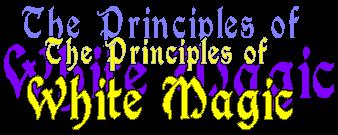An Essay on

©
2008 by Academic Services International, Los Lunas, NM, USA
![]()
.
Chapter 5
Dramatic Rituals
This chapter examines the stages of a complete ritual that involves dramatic performance. This type of rite usually involves two or more magi and is thus also known as a group ceremony.
The stages and procedures are similar to the ceremonial dynamics expounded in the previous chapter, so here there will only be the briefest mention when the same principles apply, but a rather extended exposition when the standards relate specifically to group working.
The Labor of Preparation
Preparation is, of course, required for dramatic rituals. In addition to the usual Determination, Correlation and Preparation, there is also the consideration of a script. That is, who will perform which action and who will utter what words. It is just like putting on a play, except there probably will be no rehearsals.
The following describes the elements of a generic group ceremony.
Note that different magicians may perform the various parts. That is, one person might arrange the temple, while another might see to locking the door and performing the banishing. If there is to be an evocation, then the magus who performs the invocation should also conjure the spirit - after all, it's his or her consciousness that's on the line!

The Opening
A Group Opening may vary from the singular dynamic. Sometimes a few magi may link hands in an esoteric manner, or a preliminary dialog may serve as the words that open the temple, lodge or camp.
However, at the appointed time, a magus steps up to the altar, faces east, raises the bell and strikes the battery.
! ! ! - ! ! ! ! ! - ! ! !
The Banishing
The magus replaces the bell and another magus takes up the dagger. A Banishing Ritual is then performed.
Upon completion of the banishing, this magus will set aside the dagger and proceed to kindle the fire in the censer.
The Oath
The magi then proceed to recite the Oath, which is usually intoned by the high magician (the primary magus) and repeated by the others.
The Invocation
The high magus will now place the primary incense in the censer and proceed with the Invocation.
When beginning an invocation, a different battery may be struck upon the bell.
! - ! ! ! ! - !
.
The Drama
The Dramatic Presentation then follows. Obviously, each part is enacted by a different magus. In the previous stage, it would not be improper for each individual magician to perform a separate invocation of the deity or persona they will portray.
There is not much that can be said about the drama, except that each participant should get their lines right and utter them at the correct time. Perhaps another example will make the matter somewhat clearer:
A few decades ago, a dramatic ritual was held for the education of a group of unconsecrated, public guests. It was part of an extraordinary gala held in a lodge temple. Close to four score folks attended, all being friends or family of the sponsoring magicians. This rite had far-reaching effects, the nature of which will not be further elucidated, except to say you better be careful when you lay open the esoteric rites for exoteric visitors.
The ceremony portrayed the reign of Isis (circa 2600 - 500 BC) and her historical downfall at the hands of the wicked priests of Osiris (circa 500 BC - 1900 AD), who went on to become known to mankind as a Christian autocrat. But then Osiris was superceded by his son, Horus (circa 1900 AD). all said, it was an illustrious representation of the development of the our historical epochs.
Note: Most Initiation Ceremonies are Dramatic Rituals
The Evocation
The high magus will ensure that the three corners of the triangle are activated. If incense sticks must now be lit, or if censers need to be fueled, he or she may utilize the services of an assistant.
Most dramatic rites do not include evocation. Yet in rituals of the Equinox or Solstice, it is not uncommon for the four primary elemental spirits (earth, water, air, fire) to be summoned from the four directions. But this usually is not a "full" evocation, but rather a tracing of the four invoking pentagrams of each element.
The Closing
Closing is simply the reverse of the Opening. First, the invocation is closed and the battery struck upon the bell.
! - ! ! ! ! - !
Next, the banishing is closed with the final centering and the battery struck upon the bell.
! ! ! - ! ! ! ! ! - ! ! !
This closes the circle. All fires should be extinguished and the instruments should be cleaned and wrapped in their wool or silk coverings.
The magus, and any assistants, may now exit the circle, unlock the door, resume "civilized" clothing, and plug in the telephone.
.
.
.